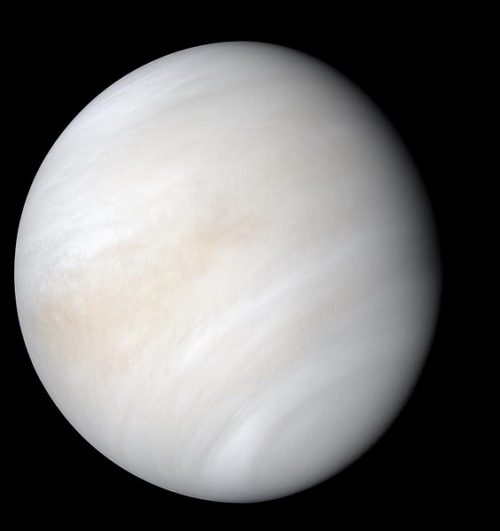Even if it is only a machine, the Parker Solar Probe is one of the most daring missions in the history of NASA. This is a spacecraft that is designed to fly around the hottest object for trillions upon trillions of miles.
The Sun!
But as groundbreaking as its heat-resistant design is, it turns out that it can do more than just check out a star. It is also extremely good at peering at other planets.
Specifically, Earth's hot-tempered sibling, Venus!
Hot and plain

What Venus looks like normally as humans would see it. (Wikimedia Commons/NASA)
Venus is well-known for its extremes. As the hottest planet in the solar system, it is completely cloaked in clouds of thick greenhouse gases that trap the heat of the Sun, choke the world in toxic poison, and crush its surface under immense pressure that can warp metal. Yikes!
All of that cloud cover also means that if you were to orbit Venus and look down, you'd see nothing of its surface. Only a beige haze. Which is what most of our photos of Venus look like.
Accidental vision
But what if you could see through the cloud cover to the surface below? One way to do that is by using radar. This is something that was done in the 1990s with a probe called Magellan. It allowed us to see the surface of the Venus, which is full of valleys and mountains.
But that is not what the Parker Solar Probe is set up for. Its camera instrument—called Wide-field Imager for Parker Solar Probe, or WISPR—is designed to capture visible light (what humans can see). But a funny thing happened when NASA decided to turn WISPR on Venus during a fly-by (Parker using the gravity of Venus to help slingshot it around the Sun).
The images that came back revealed not just a haze, but distinctly different areas. Turns out that WISPR is also able to see near-infrared light, a.k.a. heat. So blasting through the cloud cover are pictures that are like a global thermometer of Venus! Darker areas are cooler, while lighter areas are hotter.
“Venus is the third brightest thing in the sky, but until recently we have not had much information on what the surface looked like because our view of it is blocked by a thick atmosphere,” said physicist Brian Wood, lead author on the new study in a NASA press release. “Now, we finally are seeing the surface in visible wavelengths for the first time from space.”
Overall, scientists believe that by studying these images—as well as taking more—Parker can help them understand the mineral composition of Venus, as different mineral absorb and reflect heat differently!
See a bunch of these images the video below and hear what NASA experts think about all of this!
 This image compares two images of Venus. One (left) is taken by the Parker Solar Probe capturing visible anf infrared light. The second is a radar image. (NASA)
This image compares two images of Venus. One (left) is taken by the Parker Solar Probe capturing visible anf infrared light. The second is a radar image. (NASA)









